Is it possible to do something like this with WPF's ItemsControl: Demo
I am trying to freeze the GroupedItems rather than the GridView Columns.

Resources:
<Window.Resources>
<CollectionViewSource x:Key="data" Source="{Binding}">
<CollectionViewSource.GroupDescriptions>
<PropertyGroupDescription PropertyName="Date"/>
</CollectionViewSource.GroupDescriptions>
</CollectionViewSource>
</Window.Resources>
ListView:
<ListView Grid.Column="0" ItemsSource="{Binding Source={StaticResource data}}">
<ListView.View>
<GridView>
<GridView.Columns>
<GridViewColumn Header="Col 1" DisplayMemberBinding="{Binding Col1}" Width="100"/>
<GridViewColumn Header="Col 2" DisplayMemberBinding="{Binding Col2}" Width="100"/>
<GridViewColumn Header="Col 3" DisplayMemberBinding="{Binding Col3}" Width="100"/>
</GridView.Columns>
</GridView>
</ListView.View>
<ListView.GroupStyle>
<GroupStyle>
<GroupStyle.ContainerStyle>
<Style TargetType="{x:Type GroupItem}">
<Setter Property="Template">
<Setter.Value>
<ControlTemplate TargetType="{x:Type GroupItem}">
<Grid>
<Grid.RowDefinitions>
<RowDefinition Height="Auto"/>
<RowDefinition Height="Auto"/>
</Grid.RowDefinitions>
<Grid Grid.Row="0">
<TextBlock Background="Beige" FontWeight="Bold" Text="{Binding Path=Name, StringFormat={}{0}}"/>
</Grid>
<DockPanel Grid.Row="1">
<ItemsPresenter Grid.Row="2"></ItemsPresenter>
</DockPanel>
</Grid>
</ControlTemplate>
</Setter.Value>
</Setter>
</Style>
</GroupStyle.ContainerStyle>
</GroupStyle>
</ListView.GroupStyle>
</ListView>
Code behind:
public MainWindow()
{
InitializeComponent();
List<String> colList1 = new List<string>() { "Item1", "Item2", "Item3", "Item4", "Item5", "Item6", "Item7" };
List<String> colList2 = new List<string>() { "1", "2", "3", "4", "5", "6" };
ObservableCollection<Data> dataCollection = new ObservableCollection<Data>();
for (var a = 0; a < 100; a++)
{
Random rnd = new Random();
int min = rnd.Next(5000);
int rnd1 = rnd.Next(0, 6);
int rnd2 = rnd.Next(0, 5);
dataCollection.Add(new Data()
{
Date = DateTime.Now.AddMinutes(min).ToString("hh:MM tt"),
Col1 = colList1[rnd2],
Col2 = String.Format("Col2: {0}", "X"),
Col3 = colList2[rnd2]
});
}
this.DataContext = dataCollection;
}
public class Data
{
public string Date { get; set; }
public string Col1 { get; set; }
public string Col2 { get; set; }
public string Col3 { get; set; }
}
